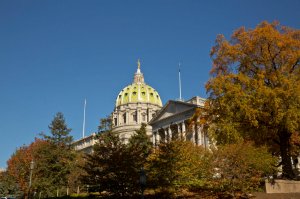By Dave Lemery | Watchdog.org

In one aspect, Pennsylvania is just now recovering from the Great Recession.
At the end of the 2018 fiscal year, the state put $22 million in its rainy day fund, which is a pool of money states set aside to cover any general expenses when the economy takes an unexpected downturn. It marked the first time since 2010, when it earmarked $745,000, that the state was able to put money in the fund.
A recent report by the Pew Charitable Trusts shows the commonwealth lags far behind most states when it comes to having a reserve. In fact, only three states – Kansas, Montana and New Jersey – saved less than Pennsylvania.
Pennsylvania’s fund is not enough to cover state government operations for more than a couple hours, Pew data indicates. That’s compared to the U.S. average of more than 23 days. The report didn’t factor in the recent deposit, but experts say that really is just a drop in a bucket.
“This is a step in the right direction,” said Justin Theal, a Pew officer. “However, the $22 million will not be enough to significantly increase its ranking for fiscal 2019.”
Nearly two decades ago, the state had a rainy day fund that would cover government expenses for about three weeks. The state used those funds in wake of the recession that started in 2001. In the preceding years, the state had built a reserve of $755 million by the time the next recession hit in 2008, but those funds transferred to the state’s General Fund in 2009.
The state made the one-time deposit a year later but then suspended making deposits through 2016.
In his most recent budget address, Gov. Tom Wolf touted bolstering the rainy day fund by setting aside 50 percent of any General Fund surplus at the end of the fiscal year. Based on the plan Wolf presented to the legislature last month, another $11 million would go to the fund after June.
“Continued focus on efficiencies, including employing the continuous process improvement practices of lean management, allows the commonwealth to maintain fiscal stability and enables further planned transfers into the Rainy Day Fund resulting in a projected balance of more than $278 million by 2024,” the 2019-2020 budget proposal said.
Some, however, are skeptical.
Michael Torres, a senior communications officer for the Pennsylvania-based free-market think tank Commonwealth Institute, said the state’s lack of a rainy day fund is evidence of rampant overspending. He noted the state’s Independent Fiscal Office estimates a $1.6 billion deficit next year.
The Institute supports a proposal that would tie government growth to a combination of inflation and population growth. It also would put any surplus into the rainy day fund.
“Given the fact that our state government is unable to spend within its means during good economic times like now, a solution must be found to ensure that they don’t have to raid the people’s wallets when the economy turns,” Torres said.








